Awards and decorations of Nazi Germany were military, political, and civilian decorations that were bestowed between 1923 and 1945, first by the Nazi Party and later the state of Nazi Germany.
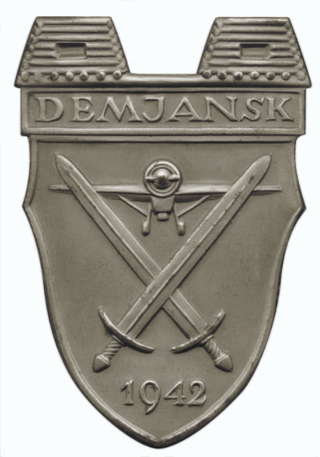
Demyansk Shield was a World War II German military decoration awarded to Wehrmacht personnel who fought in the Demyansk pocket on the Eastern Front in the early months of 1942. The pocket of German troops had been encircled and cut off by the Red Army around Demyansk (Demjansk), south of Leningrad, and was successfully defended with the aid of an airbridge. The shield was instituted on 25 April 1943 by Adolf Hitler and was not bestowed after 1 July 1944.

The Destroyer War Badge as a World War II German military decoration and awarded to officers and crew for service on Kriegsmarine destroyers. It was instituted on 4 June 1940 by Grand Admiral Erich Raeder following the battle of Narvik. It was also awarded to the crews of torpedo boats and fast attack craft until the institution of the Fast Attack Craft War Badge.

The Fast Attack Craft War Badge or S-Boat War Badge was a World War II German military decoration awarded to members of the Kriegsmarine for service on fast attack craft or patrol/torpedo boats. The award was instituted on 30 May 1941. Requirements to receive the award included: an outstandingly successful sortie, wounded in action, 12 sorties against enemy vessels or installations, or outstanding leadership.
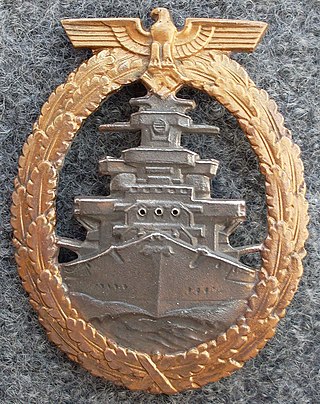
The High Seas Fleet Badge, also known as High Seas Fleet War Badge, was a World War II German military decoration awarded for service to the crews of the Kriegsmarine High Seas Fleet, mainly of the battleships and cruisers, but also those ships that supported them operationally for which there was no other award given. Although the award was instituted in April 1941, it could be awarded for actions that took place prior to this date. It was "primarily in recognition of the sea struggle" against the British fleet.

The Naval Artillery War Badge or War Badge for the Coastal Artillery was a World War II German military decoration awarded to the crews of Kriegsmarine land-based marine artillery and anti-aircraft units. It was presented to personnel of coastal defense units, and anti-aircraft units. The award was instituted on 24 June 1941 by Grand Admiral Erich Raeder to reward the actions of both individuals and crew members. It was also awarded to those killed in action in said units.
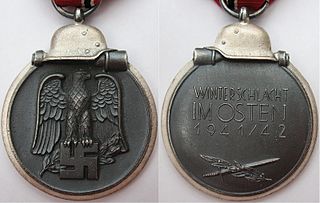
The Eastern Medal, officially the Winter Battle in the East 1941–42 Medal, was a military award of the Wehrmacht which was created by ordinance of Adolf Hitler on 26 May 1942.
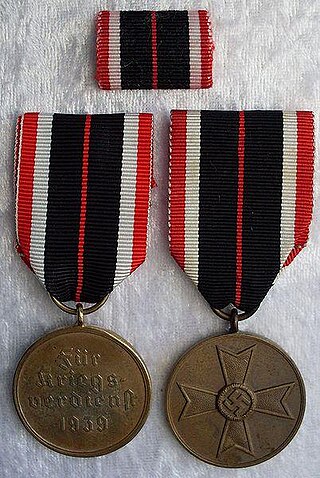
The War Merit Medal (Kriegsverdienstmedaille) was a World War II German military decoration awarded to recognize outstanding service by civilians in relation to the war effort. It was instituted on 19 August 1940 and usually awarded to those workers in factories who significantly exceeded work quotas. The War Merit Medal was awarded only to Germans and non-Germans civilians, to men and women. An estimated 4.9 million medals were awarded by the end of the war in Europe. It was closely related to the War Merit Cross, which could be awarded to military personnel and civilians alike for outstanding service to the war effort.
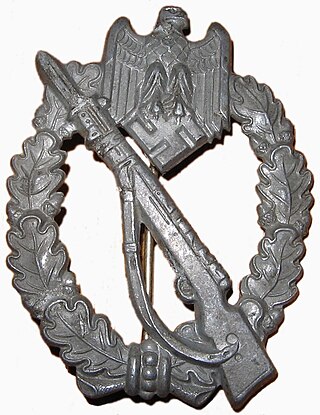
The Infantry Assault Badge was a German military decoration awarded to Waffen-SS and Wehrmacht Heer soldiers during the Second World War. This decoration was instituted on 20 December 1939 by the Commander-in-Chief (Oberbefehlshaber) of the German Army, Generalfeldmarschall Walther von Brauchitsch. It could be awarded to members of infantry and Gebirgsjäger units that had participated in infantry assaults, with light infantry weapons, on at least three separate days of battle in the front line on or after 1 January 1940. When a counter-offensive led to fighting, it could also apply. Award of the Infantry Assault Badge was authorized at regimental command level, and mechanized or motorized infantry were not eligible for the original badge. A bronze variant of the Infantry Assault Badge was created in June 1940, authorized for motorized and mechanized infantry units, using similar requirements for award as the original silver variant. Non-infantry personnel were not eligible for either grade of the Infantry Assault Badge, but were eligible for other combat recognition badges, usually the General Assault Badge, Close Combat Clasp, or the Panzer Badge. The Luftwaffe would develop its own ground combat badge in 1942, the Ground Assault Badge.
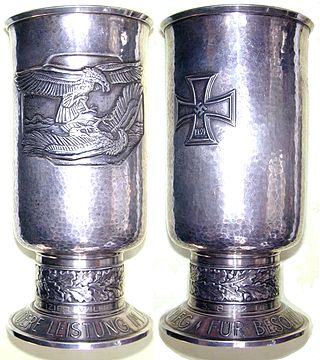
The Ehrenpokal der Luftwaffe was a Luftwaffe award established on 27 February 1940 by Reichsmarschall Hermann Göring, the Reich Minister of Aviation and Commander-in-Chief of the Luftwaffe. It was officially known as the Ehrenpokal "für Besondere Leistung im Luftkrieg", or Honor Goblet "For Special Achievement in the Air War". The award was given only to flying personnel. Recipients' named were published in the periodical Ehrenliste der Deutschen Luftwaffe. German archives indicate that approximately 58,000 were given "on paper", but only 13–15,000 goblets were actually awarded according to the records. The first airman to receive the goblet was Oberstleutnant Johann Schalk on 21 August 1940.

The U-boat Front Clasp or U-boat Combat Clasp, was a World War II German Kriegsmarine military decoration awarded to holders of the U-boat War Badge to recognize continued combat service and valor.

The Front Flying Clasp of the Luftwaffe was a World War II German military decoration awarded to aircrew and certain other Luftwaffe personnel in recognition of the number of operational flights flown. It was instituted by Reichsmarschall Hermann Göring on 30 January 1941. It was awarded in Bronze, Silver, and Gold with an upgrade to include diamonds possible. Pennants suspended from the clasp indicated the number of missions obtained in a given type of aircraft. Front Flying Clasps were issued for missions completed in the following Luftwaffe aircraft:
The Honour Roll Clasp was a decoration of Nazi Germany during World War II. There were different versions for the Army (Heer), Air Force (Luftwaffe) and Navy (Kriegsmarine).
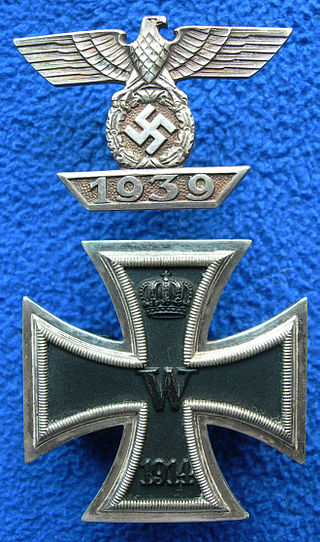
The Clasp to the Iron Cross was a white metal medal clasp displayed on the uniforms of German Wehrmacht personnel who had been awarded the Iron Cross in World War I, and who again qualified for the decoration in World War II.

The Minesweeper War Badge or Minesweepers, Sub-Chasers and Escort-Vessel War Badge was a World War II German military decoration awarded to Kriegsmarine members for service on minesweepers vessels. The award was instituted on 31 August 1940 by Grand Admiral Erich Raeder. It was first awarded on 28 November 1940.

Anti-Aircraft Flak Battle Badge was a World War II military decoration of Nazi Germany. It was instituted on 10 January 1941 by Hermann Göring in his capacity as the Commander in Chief of the Luftwaffe. The badge was awarded to servicemen of the Flak artillery who distinguished themselves in action against enemy aerial or ground attacks.
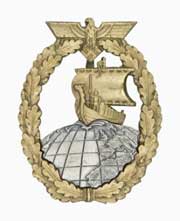
The Auxiliary Cruiser War Badge was a World War II German military decoration awarded to officers and men of the Kriegsmarine for service on Auxiliary Cruisers or the supply ships that supported them for a successful large voyage. The award was instituted on 24 April 1941 by Grand Admiral Erich Raeder.
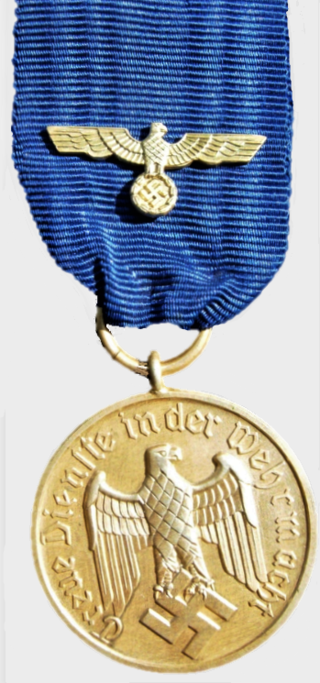
The Wehrmacht Long Service Award was a military service decoration of Nazi Germany issued for satisfactory completion of a number of years in military service.

The Army Anti-Aircraft Badge or Army Flak Badge was a German military decoration awarded to German Army personnel for service in an anti-aircraft battery during World War II. Designed by Wilhelm Ernst Peekhaus, it was of single piece construction. The pin back and clasp badge was grey metal in color. The badge was made in one grade; it had the national eagle at the top and an oak leaf wreath around the outside rim. In the middle was an 88 mm flak gun with the barrel facing upwards to the "viewer's" right.
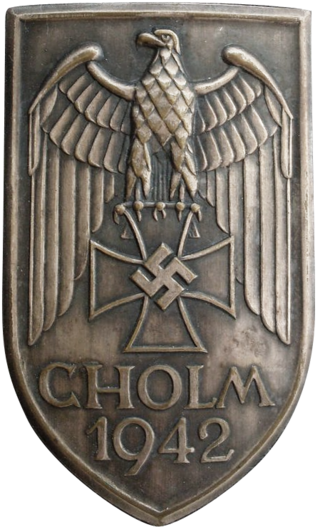
The Cholm Shield was a World War II German military decoration awarded to those who fought in the Cholm Pocket on the Eastern Front between 21 January and 5 May 1942. It was instituted on 1 July 1942 and is the rarest of the German combat shields, with approximately 5,500 recipients. Awards ceased to be bestowed on 1 April 1943.


















